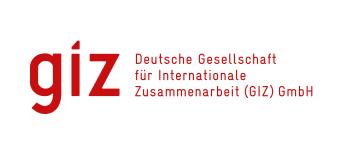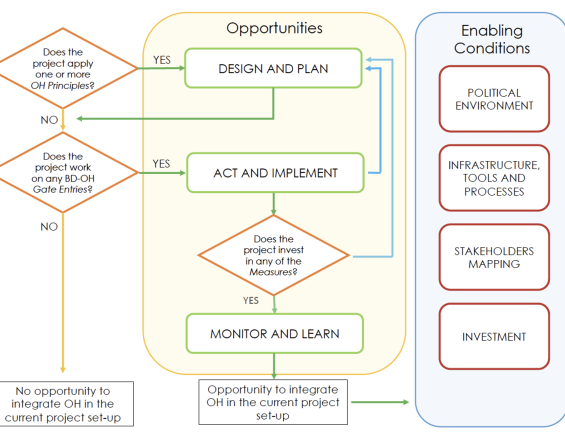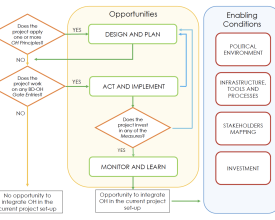
An Analysis Framework to enable biodiversity projects to take a One Health approach

The Biodiversity Working Group from GIZ’s Sector Network of Rural Development and Natural Resources Asia-Pacific (SNRD-AP) commissioned a study to explore the biodiversity-health nexus in the region. Literature review and informant interviews allowed understanding the impact of biodiversity loss and ecosystem degradation on human and animal health and gave insight into the value of collaboration at the nexus. The leading discourse has neglected the environmental pillar of One Health (OH) for long, with little attention given to biodiversity in classic OH actions addressing emerging infectious diseases and antimicrobial resistance. The biodiversity-health nexus is essential for pandemic prevention. It is thus urgent to explore how One Health could be integrated into biodiversity and, vice versa, how biodiversity could be integrated into One Health to make pandemic prevention more effective. This study focuses on developing an innovative tool to guide better integration of One Health into biodiversity conservation.
Context
Challenges addressed
Loss of biodiversity in terrestrial ecosystems is caused by several factors, such as ecosystem degradation due to land use changes, climate change, extractive industries and exploitation of forest products, wildlife trade and consumption. These drivers reduce the physical distance between humans, their domestic animals, and wildlife populations, increasing the risk of spillover of zoonotic pathogens from animals to humans. Southeast Asia is a biodiversity hotspot and one of the fastest developing regions in the world. Environmental degradation makes the region a risk area for the spread of zoonotic diseases. The value of One Health in tackling these issues is well-recognised. However, there is no clear path for biodiversity projects on how to recognize contributions to health outcomes and integrate One Health in their work. The Analysis Framework offers projects a uniform assessment tool to discover strengths and potentials and analyse where and how multisectoral OH collaborations can be initiated.
Location
Process
Summary of the process
The building blocks interact with each other to allow exploring the biodiversity-health nexus in biodiversity conservation projects and identifying where and how multisectoral One Health collaborations can be initiated. Forming a multidisciplinary review team is the first step of the process. The team will be tasked with the responsibility of quickly scanning the project using the Analysis Framework purposely developed and here described as Solution for the integration of One Health in biodiversity. This will allow identifying the gate entries that have the potential to link with the OH approach and leveraging already implemented measures to effectively operationalise it. The next step requires the exploration of enabling conditions that can influence the real actualisation of the identified OH intervention. Finally, the review team will guide a multisectoral and transdisciplinary discussion on the integration of One Health in the project, by engaging all project owners (institutional and development partners) and all actors affected by the intervention (policy makers, local communities and service providers).
Building Blocks
FORM A REVIEW TEAM
Once formed, a review team will lead the analysis of the project and the potential integration of the One Health approach. It is key to initiate a discussion across sectors, identify opportunities of collaboration among stakeholders, and enable the co-design of One Health components that align with and push the project goals towards a holistic approach to the biodiversity-health nexus. The review team is multidisciplinary and should be made up of all the project owners, including institutional and development partners.
Enabling factors
- Multidisciplinary composition of the review team, including experts from different sectors (e.g., conservation, animal health, human health, education, social science)
- Transdisciplinary composition of the review team, including experts from different levels of intervention and with different roles (e.g., researchers, policymakers, service providers, community members)
Lesson learned
External assessors can greatly contribute and amplify the outcomes of the project analysis at the biodiversity-health nexus. They can guide the project team through the analysis process providing a fresh and independent perspective to the project analysis. External assessors should have some sort of experience in multisectoral collaborations and One Health to guide the review team in the project analysis and identification of opportunities to integrate a more holistic approach.
QUICK SCAN OF THE PROJECT
The first step of the analysis is to assess if the project is applying one or more OH principles within its scope of work. Seven OH principles, adapted from the literature, are used in the framework (i.e., multisectoral, transdisciplinary, participation, prevention, decentralisation, evidence-based, multi-scalar). Not all principles in the framework have equal value, with the multisectoral principle considered an essential component in the proposed tool. The reason for this is that the basis of One Health is the collaboration among different sectors. The framework allows multisectoral collaborations at any level, for example where an MoU has been signed between ministries, or at community level through the joint effort of village health workers, animal health volunteers and rangers.
Enabling factors
- Refer to the provided definitions of each principle to ensure a correct understanding of its meaning in reference to the analysis framework
- Review the project simply by looking for the mere application of principles and avoid jumping to quick conclusions regarding the adoption of the One Health approach
Lesson learned
A quick scan of the project gives insight into the project’s current state. If the project already applies one or more OH principles, there are immediate opportunities to design and plan a One Health component within its scope of work. However, failure to apply even a single principle does not prevent the One Health approach to be implemented, nor does it imply that the framework analysis has to stop. The quick scan of the project will help to clarify what principles need to be explored and included to successfully implement a One Health approach.
IDENTIFY GATE ENTRIES
Gate entries are thematic areas in which the project conducts activities or actions that have the potential to link into a OH approach. They represent real opportunities to integrate and transform project goals and One Health goals into a common goal. At the biodiversity-health nexus, the framework identifies five main key gate entries: Emerging Infectious Diseases and Zoonoses, Agriculture Production and Food Safety, Climate Change and Risk Reduction, Wildlife Trade and Consumption, and Biodiversity Conservation (including Nature-Based Solutions, Protected Areas, and Wildlife Management).
Enabling factors
- Refer to the provided definitions of gate entries to ensure a correct understanding of their meaning in reference to the analysis framework
Lesson learned
There may be more than one gate entry to the biodiversity-health nexus in the same project. However, it is recommended to focus only on one gate entry to initiate the integration of the OH approach. The process requires efforts and resources to establish new partnerships, co-design new project components, and put in place measures and infrastructures to allow the communication, collaboration, coordination and capacity building across sectors and disciplines. A narrow focus can ease the process and increase the rate of success. Evidence generated in small-scale initiatives can eventually support their replication at a wider scale and inform the development of policies on the operationalisation of One Health in biodiversity-related projects.
LEVERAGE MEASURES
Measures are interventions or activities that are already implemented in the project and can allow building a One Health component within its scope. They enable the operationalisation of the One Health integration in an optimal and relevant way. The framework identifies eight measures, including Education and Awareness, Policy Development, Capacity Development, Collaborative Platforms, Community Engagement, Information Sharing, Surveillance and Early Warning, and Research.
Enabling factors
- Refer to the provided definitions of each measure to ensure a correct understanding of its meaning in reference to the analysis framework
- Review the project simply by looking for the gate entries and avoid jumping to quick conclusions regarding the adoption of the One Health approach
Lesson learned
The measures proposed in the analysis framework are commonly found in biodiversity and conservation projects. The challenge here is to leverage them to allow the integration of the One Health approach in the project. The activity or component can be re-designed and re-planned working across sectors and adding the perspectives of different disciplines and actors. The transformed and integrated measure will increase its value and lead to bigger impacts at the biodiversity-health nexus.
EXPLORE ENABLING CONDITIONS
Enabling conditions determine the success of the OH integration in the project. Their accomplishment is necessary to create a suitable environment for sustainable and optimal collaborations and activities. The enabling conditions identified in the framework include a conducive political environment that encourages government and non-state actors across all relevant organisational levels to willingly collaborate; infrastructure, tools and processes that ease the sharing of data and enable the co-design of multisectoral interventions at the human-animal-environment interface; a detailed stakeholder mapping that allows the identification of strengths and potentials across different actors and promotes the establishment of valuable collaboration; and a meaningful investment that sustains the application of the One Health approach in new or existing project.
Enabling factors
- Conduct a thorough analysis of the policy context in the country of intervention, to identify government and non-state initiatives that support OH operationalisation
- Analyse the infrastructures and assets already available in the project that can ease the collaboration and communication with other sectors and initiatives
Lesson learned
The failure to meet the enabling conditions does not automatically disqualify a project to include a One Health approach. However, it may hinder the actual operationalisation of the integration within the project. Small scale initiatives that require a limited investment may represent a viable option to pilot the integration of One Health at the biodiversity-health nexus even when not all enabling conditions are met. The initiatives will help the generation of evidence and support the case of One Health among policymakers and investors, eventually boosting the enabling conditions for future interventions.
DISCUSS OH INTEGRATION
The adoption of the One Health approach in biodiversity-related projects requires an open and participatory discussion among all actors and stakeholders involved and affected by the project itself. The discussion will build on the results of project analysis, collaboratively planning how (principles) and where (gate entries) the One Health approach can be applied and identifying what (measures) can be done to ensure integration is optimal and relevant. The review team will lead the preparation of an action plan to ensure that fundamental factors (enabling conditions) are met and guide the operationalisation of the OH component at the human-animal-environment interface.
Enabling factors
- Engage a wide spectrum of actors and stakeholders in the discussion, ensuring the representation of different sectors and groups that are affected by the project
- Promote an open dialogue among all actors, to promote exchange and integration between scientific and traditional knowledge
Lesson learned
The integration of One Health in biodiversity-related projects can be a complex process. Three strategies can ease the task and support the review team in achieving the goal. The clarification of the One Health definition in the context of the specific project to ensure all actors share the same understanding of the approach and the value of its integration in the project. The identification of a narrow scope for the adoption of the OH approach within the project to test the capacity of the team in establishing new partnerships, working across disciplines, and creating initiatives that differ from their usual business. The engagement of external assessors, experts in the operationalisation of One Health, to support the team through the collaborative process to identify the opportunities of collaboration at the biodiversity-health nexus.
Impacts
The Analysis Framework was developed to assist the SNRD-AP Biodiversity Working Group to implement the OH approach within biodiversity-related projects in the Southeast Asia region. The framework allows assessing if the project has a sufficient base for One Health and already applies key OH principles. It enables the identification of potential gate entries, where a OH element can be integrated, and assesses the measures that could allow building a OH element into the project. Through the application of the framework, owners and stakeholders are guided in the revision of the project adopting the OH lens, identifying new opportunities to work across disciplines and engaging with new actors. The framework should be considered a starting point for the transformative process of adding One Health into biodiversity. A radical shift in thinking is required to break down the process of implementing the OH approach into manageable and feasible measurements that are context- and project-specific. By doing so, small-scale actions and successes will likely increase trust in the process and pave the way for a broader integration of One Health within the conservation community. The Analysis Framework was tested on six projects to verify its validity. Tthe Biodiversity-One Health Taskforce of the SNRD-AP Biodiversity Working Group was trained on the step-by-step process to ensure its application on a wider scale.
Beneficiaries
The beneficiaries of the framework are the teams of the biodiversity-related projects within the SNRD-AP Biodiversity Working Group. On a larger scale, the tool will benefit partners and stakeholders who will learn how to integrate One Health in their work.


